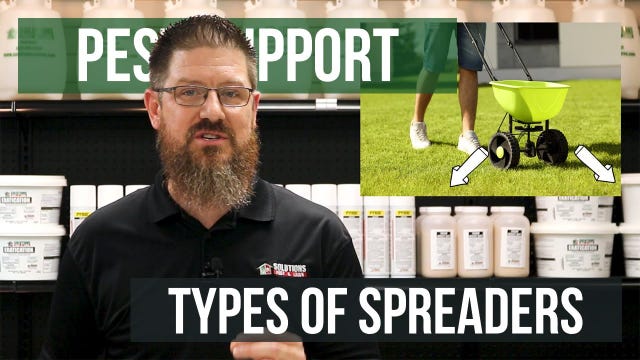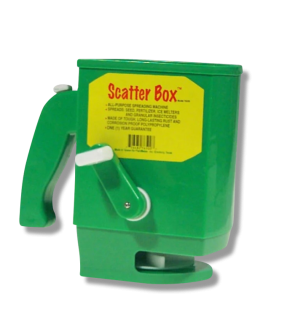Gain access to personalized product screening, the best pricing, rewards, and more!
Most Effective Products
Pros and Cons of Lawn Spreader Types
This page is a general DIY article discussing the advantages and disadvantages of each spreader type. By learning the pros and cons of each spreader type, you can efficiently and quickly apply any pesticide or fertilizer without complications or waste.
The secret to a lush, beautiful lawn depends on how much care you put into it. Beginning homeowners or gardeners will find that watering once a week with an inch of irrigation is one of the first steps they can take. However, watering can only go so far, and some homeowners have found that adding the right of fertilizers or granule formulation pesticides plays a huge factor in the lawn's appearance.
With the different project or treatment area needs, the type of spreader to use depends on the size, shape, terrain, availability of your time, and if there are immovable objects such as statues or birdbaths in your treatment area. Most importantly, the specification you desire will also help determine which fertilizer spreader is best suited for your project needs.
Most spreader types belong to one of the three categories: broadcast, drop, or handheld lawn spreaders. Each spreader comes with its own set of benefits, drawbacks, and the level of effectiveness achieved. If you are applying any granule pesticide formulation or fertilizer, then read on to learn more about each spreader type and how to select one that fits your treatment area needs appropriately.
How to Choose A Broadcast Spreader

As the name implies, a broadcast spreader will broadcast seeds, granule formulation products, and fertilizer products in large swaths. This product may be used by manually pushing or carrying behind a lawn mower or ATV. While several types of broadcast spreaders are available on the market, they will all share the same size. Due to their size, broadcast spreaders are ideal for quickly covering large-scale areas.
The product material will disperse from the bottom, front, and side. A broadcast spreader can be adjusted by its dial, affecting the amount of product released. For appropriate application rates, refer to the product label you are spreading.
Pros:
- Covers large areas in a short amount of time.
- Easily adjust the speed and distance of the product spreading.
- It saves time and energy when used during application.
Cons:
- It isn't easy to control the flow pattern of the product, and it may throw the product in areas where it is not needed. Due to the unpredictability of the swath and product effects, applications near or around flowerbeds will be difficult.
- Clean-up time may be increased if the product is in undesired areas.
- We need to move at a steady, even pace to increase the accuracy of the application.
How to Choose A Drop Spreader

Like broadcast spreaders, a drop spreader can be spread by pushing or being towed from behind, except that the product material is coming directly from the bottom. Drop spreaders will appear lower than broadcast spreaders and will have a bottom compartment only. Based on your project needs, you can have precise coverage with this type of spreader by having the product dispersed in one application or altering the flow rate.
Nevertheless, drop lawn spreaders provide a more detail-focused application of seed, weed killer, fertilizer, or granule-formulated products in small treatment areas. This also means that you would have to revisit the areas to be treated to treat the entire area. However, while the amount of product dispersed is less than that of broadcast spreaders, this makes applications in gardens and other small treatments with obstacles more ideal.
Pros:
- Allows more control and precise application of granule-based products, seeds, or fertilizers.
- It prevents overlapping materials and products from being applied in undesired areas due to wind since it is applied directly from the bottom.
- Treating near trees and small areas under 5,000 sq. ft. with few obstacles, such as statues, birdbaths, and immovable objects, is ideal.
Cons
- Distribution from the product is lesser than broadcast and may result in multiple passes to cover the entire treated area, leading to time consumption.
- Spreading material in large areas is not recommended.
How to Choose A Handheld Spreader

Compared to the other spreaders listed in this article, a handheld lawn spreader is the most portable and affordable option. This equipment is most suitable for small yards, flowerbeds, gardens, and areas with impending objects.
This tool manually cranks to disperse the seed, fertilizer, or granule product. Unlike drop spreaders, the product will be released from the downward-facing compartment, except that it is being manually cranked. As the product is released from the handheld spreader, the rotary paddle will push the material through small and precise swaths.
Unfortunately, due to their size, these types of spreaders are not ideal for treating medium to large scale treatment areas and are best suited for small areas and landscape beds.
Pros:
- Handheld Spreaders are ideal for treating small areas that require precise application.
- Often comes conveniently pre-assembled in the box.
- Compared to other types of spreaders, it is the cheapest option.
- It is easy to use as you will only hand-crank the tool to apply the product.
Cons:
- It is not suited for medium to large-scale areas and will result in fatigue if attempts are made in these areas.
- Treats only small areas such as flowerbeds, landscape beds, and around gardens.
- Product application is likely inaccurate due to a higher risk of drift since handheld spreaders can be held higher off the ground than other spreaders.
It is always recommended to know the formulation of the product you have selected and evaluate the needs of your project, as this will help to lead your decision. Despite the model of the spreader you are using, it is best to move at a steady pace when using the spreader model. When using any product and spreader, you must wear the appropriate personal protective equipment (PPE).
Key Takeaways
What are the Main Types of Spreaders?
- Spreaders will be either a broadcast, drop, or handheld model.
When to Use Spreaders
- Broadcast spreaders will be used for large-scale areas around 1,000 sq. ft., such as fields or acres of property. Drop spreaders are best suited for small areas with few obstacles, whereas handheld spreaders should be used in and around small areas, such as flowerbeds, with objects that cannot easily be moved.
Products to Use for Spreaders
- Spreaders are ideal for seeds, some fine granules, and fertilizers.







